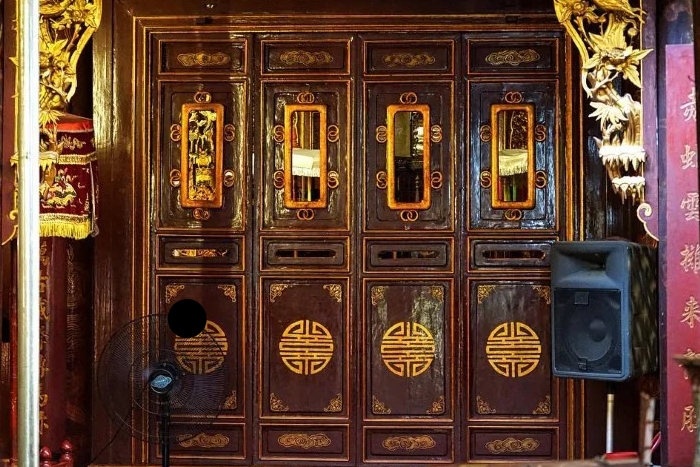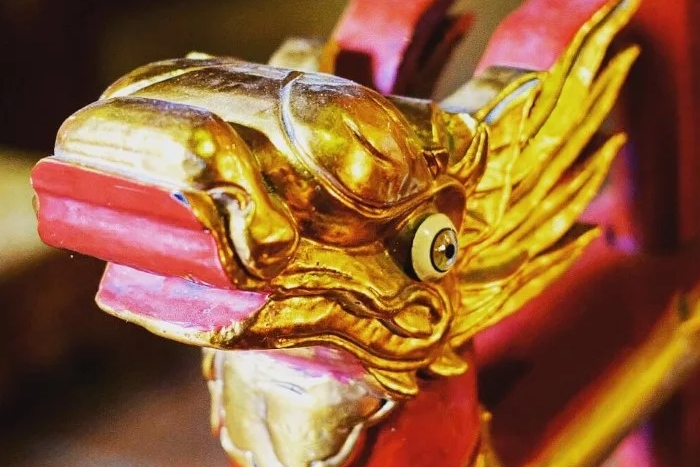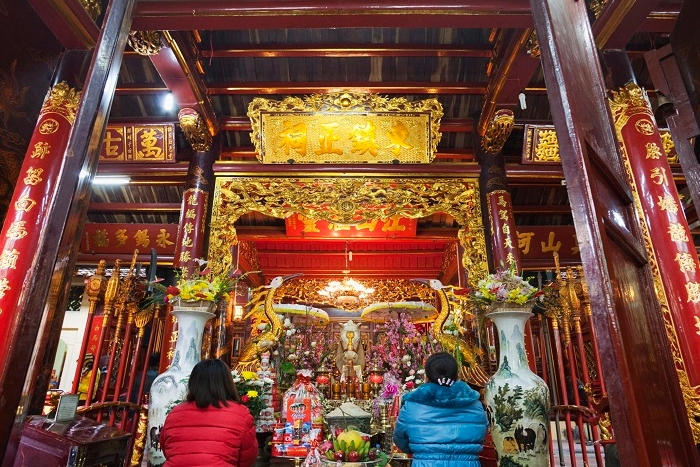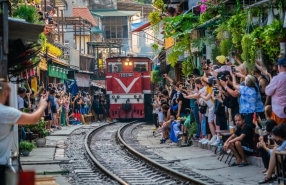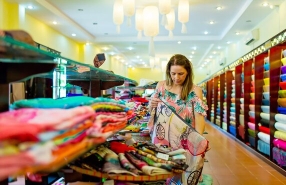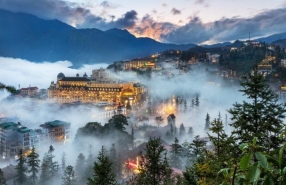Bach Ma Temple, an enduring ancient sanctuary, serves as a living repository of historical imprints within the heart of Hanoi. Housing precious relics and boasting a distinctive architectural allure, this temple in Hanoi stands as an indispensable attraction for those eager to delve into the rich tapestry of Vietnamese history and culture. Let's explore what is interesting about this ancient temple in Hanoi Old Quarter !
I. Introduction about the Bach Ma temple and how to get it ?
1. Introduction about the Bach Ma temple
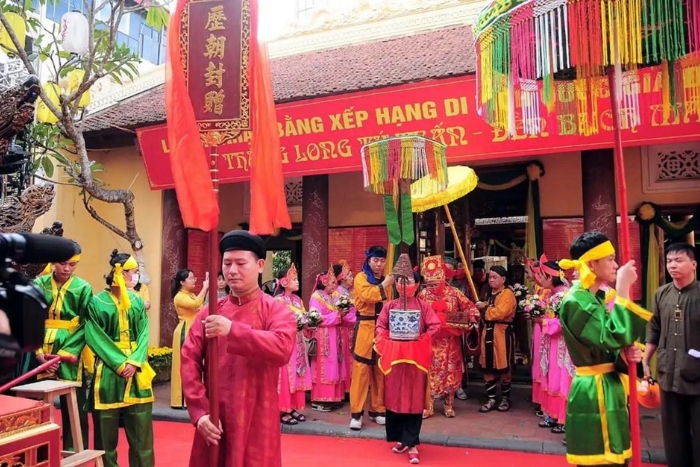
Situated at 76 Hang Buom, in the heart of Hanoi's Old Quarter and in close proximity to Hoan Kiem Lake, Bach Ma temple stands as a captivating historical site intertwined with the momentous capital relocation orchestrated by King Ly Thai To. Recognized as one of the Four Protective Pagodas encircling the Thang Long Citadel, it delineates the boundaries safeguarding the city.
Bach Ma temple Vietnam boasts a distinctive ancient architecture, serving as a sacred space for invoking good fortune. Renowned among locals and frequented by both domestic and international tourists, Bach Ma Temple holds a special place in the collective consciousness of those who visit.
2. How to get there?
There are many ways to get to Bach Ma temple Hanoi, below are some of our suggestion you can refer to:
- By Public Transportation : Hanoi has a well-developed public transportation system. You can use buses to reach the Hoan Kiem District where Bach Ma Temple is located. You can choose one of the following routes: 01, 14CT, 18, 22A, 34, 18, 43 with stops near Bach Ma Temple.
- By Taxi or Ride-Sharing : Taxis and ride-sharing services are readily available in Hanoi. You can use popular services like Grab or Mai Linh Taxi to reach the temple.
- By Walking : Depending on your location in Hanoi, if you are staying in the Hanoi Old Quarter or nearby areas, it may be possible to reach Bach Ma Temple on foot.
II. Legend of the Bach Ma in Hanoi Old Quarter
The legend of Bach Ma Temple is one of the most famous legends about the Thang Long capital. According to legend, in the 9th century, when the Tang Dynasty colonized our country, a Vietnamese Mandarin named Long Do had merit in helping the people fight against domination. When he died, people built a temple to worship him in the east of Dai La citadel (Thang Long). In 1010, King Ly Cong Uan decided to move the capital from Hoa Lu to Thang Long. When digging trenches to build the citadel, the citadel collapsed many times, making the king and people extremely worried. Someone told the king that there was a very sacred deity at Bach Ma temple. If the king goes to pray there, it will be successful.
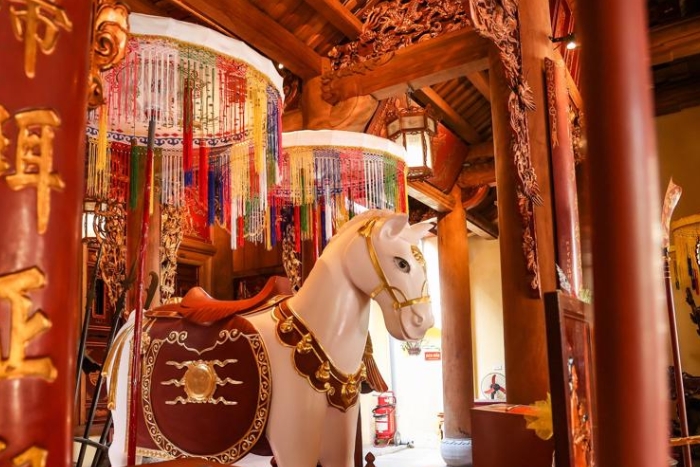
King Ly immediately sent people to this temple in Hanoi to pray. One morning, a white horse left the temple and ran around the area under construction, leaving footprints wherever it ran. King Ly followed the horse's footsteps to build the citadel, and the citadel did not collapse again. From then on, the citadel was raised high and very solid. From then on, King Ly Cong Uan appointed the god Long Do as Thanh Hoang, protecting the capital city of Thang Long. The white horse also became a sacred symbol of the Bach Ma temple.
III. The special of the architecture of Bach Ma temple Vietnam
Bach Ma temple Vietnam has great architectural features in both the interior and exterior. There is a big flag called “Co Ngu Hanh” with five colors (red, yellow, green, white, and blue) symbolizing the five elements in oriental culture (fire, earth, wood, metal, and water) respectively. Each color also symbolizes a direction, with blue representing the north, white for the west, green for the east, red for the south, and yellow for the center with the special of the architecture
1. Three-entrance gate ( Cổng Tam Quan)
The three-entrance gate of Hanoi Bach Ma temple was built in the style of “Tam Quan Ngoai - Tam Quan Noi” (External three-entrance gate - Inner three-entrance gate), including two small gates located inside one large gate. The large gate is built of baked bricks, has two floors of overlapping roofs, and is covered with funny-nosed tiles. The corners of the gate's roof are carved with images of flanking dragons, creating a majestic and majestic look for the temple.
The two small gates located inside the large gate are similarly built, but smaller in size. All the gates are carved with intricately patterned reliefs, carrying spiritual and feng shui meanings. These reliefs mainly depict images of fairies and mascots such as dragons, phoenixes, elephants, tigers, pigs, etc., meaning to pray for peace and prosperity for the villagers.
2. The front Hall of Bach Ma temple Hanoi (Tiền Đường)
The front hall of Bach Ma temle Vietnam is a unique architectural work, bearing bold characteristics of traditional Vietnamese architecture. The street frontage is built in the "giá chiêng chồng rường con nhị" style, with two roof floors. The roof above is covered with lapis tiles, the corners are curved like dragon wings. This roof system is supported by sturdy ironwood trusses, meticulously carved.
The facade has a "Dinh" shaped structure, 13.5m long, and 7.5m wide. The main hall's facade is decorated with carvings of dragons, phoenixes, lotus flowers, and parallel sentences. These carvings are elaborately and delicately executed, demonstrating the talent of ancient artisans.The front hall is where the worshiping ceremony of Bach Ma temple takes place. This is also where visitors can admire the unique architectural beauty of the temple.
3. The harem of Bach Ma Temple ( Hậu Cung)
Bach Ma Temple's harem is the place to worship Bach Ma God, the god who protects the capital Thang Long (present-day Hanoi). The harem was built in the traditional three-compartment "chuôi vồ" style. The middle compartment is where the statue of Bach Ma god is carved from wood and painted gold. The two side compartments worship gods, including Qi Vuong Phi who is said to be the wife of the god Bach Ma.
The harem is decorated with intricate carvings, imbued with traditional Vietnamese architecture. The carved works mainly depict images of dragons, phoenixes, lotus flowers, and Chinese couplets. The roof system of the harem is covered with lapis tiles, with curved corners like dragon wings. This roof system is supported by sturdy ironwood trusses, meticulously carved.
The harem of Bach Ma temple is a unique architectural work, rich in historical and cultural value. This harem is one of the outstanding highlights of the temple, contributing to the ancient and majestic beauty of the temple.
Though much of the current structure reflects 18th-century renovations, the temple retains its ancient charm. Its red-tiled roof curves gracefully over intricately carved wooden pillars, adorned with vibrant murals depicting scenes from Vietnamese mythology and folklore. The serene courtyard invites quiet contemplation, offering a welcome respite from the surrounding city's energy.
Inside the temple, the air is thick with the scent of incense as devotees light candles and offer prayers before the altar. Statues of Long Do and other deities, including the scholar Confucius, grace the sacred space. Visitors can also admire the beautifully preserved artifacts, including ancient pottery and ceremonial objects, that offer a glimpse into Hanoi's past. In 2023, it was recognized as a "Special National Relic Site" by the Vietnamese government, highlighting its exceptional cultural and historical value.
Today, Bach Ma temple is still one of the most sacred temples in Hanoi and an important part of Hanoi's spiritual landscape. This temple also hosts traditional festivals and ceremonies throughout the year, providing a vivid perspective on Vietnamese culture and traditions. Bach Ma Temple Festival is held every year on the 13th day of the second lunar month. This is a big festival, attracting a large number of people from Hanoi and neighboring provinces to attend to pray for blessings, good luck, and blessings with their ancestors. The festival has many traditional rituals such as palanquin processions, Cheo singing, water puppet shows, etc..
IV. Some useful advices for your trip to Bach Ma temple Vietnam
- Dress Modestly : As a place of worship, it's important to dress modestly out of respect. Wear clothing that covers your shoulders and knees.
- Footwear : You'll likely need to remove your shoes before entering the temple premises. Wear slip-on shoes or sandals to make this process easier.
- Respectful Behavior : Keep in mind that this is a sacred site. Maintain a quiet and respectful demeanor, especially inside the temple buildings.
- Photography : Check for any signs or ask the staff if photography is allowed. In some religious sites, taking photos may be restricted or prohibited.
- Cultural Sensitivity: Be aware of local customs and traditions. Avoid pointing your feet at religious objects or people, as it is considered disrespectful in many Asian cultures.
- Plan Nearby Attractions: Since you're in the area, consider planning your visit to other nearby attractions or landmarks to make the most of your time in Hanoi.
Whether you are interested in history, religion, or simply seeking a quiet moment of reflection, the
Bach Ma temple is a must-visit for anyone exploring Hanoi. It's a place to step back in time, experience the city's heart and soul, and connect with the ancient spirit that continues to watch over Hanoi. Its timeless beauty and spiritual significance make it a true treasure of the city. If you want to know more useful information about Vietnam travel, don''t hesitate to
contact Autour Asia - one of the best travel agencies in Asia.

